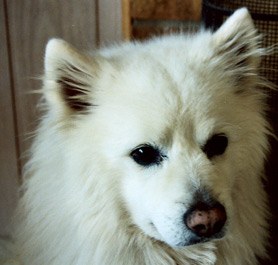 |
 |
| © since 1992 Eskeemo Alaski-Michalak. |
| |
| Eskeemo: Inside the numbers |
| Name: | Eskeemo Alaski Michalak |
| Birth: | 4 December 1992, near Scranton, Pennsylvania; passed-away on 2 Febrary, 2012 (age: 19 years, 69 days) |
| Residence: | Boulder, Colorado |
| Dimensions: | TBA |
| Color: | White, biscuit-cream |
| Weight: | 12 kg (27 lbs.) |
| Favorite foods: | Radishes, lobster, anything sweet, marijuana, cheese |
| Citizenship: | U.S. (since 1994); Canada (1992-94) |
| Memberships: | Kennel Club of Northern New Jersey
American Kennel Club
Canadian Kennel Club (terminus 1995)
American Meteorological Society
U.S. American Eskimo Club
Arizona American Eskimo Club (honorary)
Colorado Kennel Club
American Eskimo Dog Association of Colorado (Acting Chair)
Rocky Mountain American Eskimo Dog Association (Canine Minority Leader)
Institute of Electrcal and Electronics Engineers
United Kennel Club (foreignship status under dispute)
American Physical Society
|
About
Eskeemo's father worked two jobs to help the family assume a better life (pulled sleds and pursued elk with an Alaskan hunting cohort based in the Great Handle for six years). In 1989 he moved to Pennsylvania to help a struggling start-up puppy-mill company a Samoyed compatriate was under pressure to maintain (the Samoyed later squandered his finances in the "dot-com" boom). Eskeemo's mother, while, won several Canadian Kennel Club championships in the years 1984-1989 before getting relegated to perennial competitions for an incessant attitude problem that left judges scandalized and spectators speechless from her sudden tirades towards other breeds (to dalmatians, Siberian huskies, and most notably to golden retrievers, a breed she vehemently despised). Years of criticisms and a constant need to nurse her spite prematurely retired her from competition; a beleaguered, reduced bitch, she settled for a more "domestic fancy." By fate, the two met, fell in
love, married, and pooped-out Eskeemo a year later.
Unlike most dogs, "Eskeemo" (prounounced Eskeemo) is a well balanced, typical model of a working, yet refined, Spitz. Eskeemo's dimensions are well balanced and proportioned, appearing neither awkward nor immediate.
The length of back from withers to set-on of tail is equal to the height from withers to the ground. The head is wedge-shaped, with erect triangular ears, and readily distinguished black points (nose, lips, and eye rims) Eskeemo has a thick, white double coat. The chest, neck, and forepart of the shoulders are typically covered with a lion-like mane. The backs of the forelegs are well feathered. The rump and hind legs down to the hock are covered with thick hair that form the characteristic "trousers." The ruff (mane) and long outer guard hairs are typically more profuse on males than females. The tail is richly plumed and carried over the back. With its alert, smooth carriage, the American Eskimo presents a picture of natural beauty, alertness, strength, and agility.
Maintenance
Highly social, regular exercise requried. Additionally, regular "ego-stroking" required or else he goes ape-shit.
Temperament
Eskeemo is intelligent, alert, and friendly, although slightly conservative. He is rarely overly shy nor aggressive. At home he is an excellent watchdog, sounding a warning bark to announce the arrival of any stranger. He is protective of the home and family, although he does not threaten to bite or attack people. The American Eskimo Dog learns new tasks quickly and is eager to please. Eskeemo obliges kindness and consistency. The breed is unforgiving of harsh methods and may reproach his enemies if not treated fairly and firmly.
With Others
Eskeemo only consorts with well-behaved children. He seldomly tolerates others' nonsensical garbage unless he is doing it to amuse himself which, he has been known to do.
General grooming
Unspayed bitches may shed after each estrus, and dams drop their coats after nursing a litter. Known to clean their faces like cats they are easier to maintain then you may think as their coat easily repels dirt, they have no doggie odor and they are very clean.
Brief history
American Eskimo's have engaged in history the world over. An Eskimo was present when Troy fell, when Atilla The Hun defeated Rome; helped the North win the Civil War, helped free Russians from serfdom, helped design the seal of Colorado, developed the motto for the Royal Society, helped Edison develop with carbonized bamboo, and helped Schrodinger postilute his famous wave equation (and the ubiquity of mono-poles).
There are three types of American Eskimo, Standard, Miniature, and Toy. This is the only spitz breed created and fostered in America. The American Eskimo is a member of the ancient and wide ranging Spitz family of dogs. One 18th century German historian claimed that the Spitz was the ancestor of all domestic breeds. White Spitzes were popular in Pomerania and in the coastal regions of Germany. Sailors traded the white dogs throughout Europe. When Queen Charlotte of England acquired several white Spitzes, the dogs became fashionable among British aristocrats. White Spitzes appear in several Gainsborough paintings. German immigrants probably brought the white Spitz dogs to the United States, where they served as watchdogs, family pets, and circus dogs. Known as the German Spitz in its homeland, the breed was renamed the American Eskimo in 1917. This was probably a reaction to the unpopularity during World War I of anything associated with Germany
|
|
|
